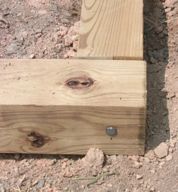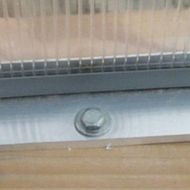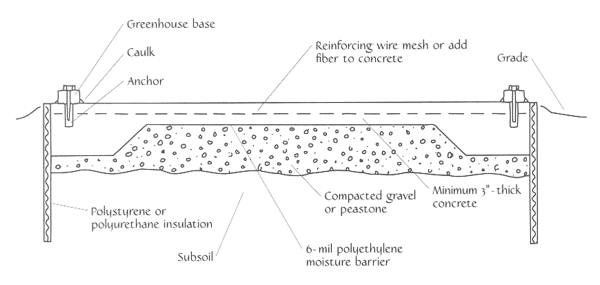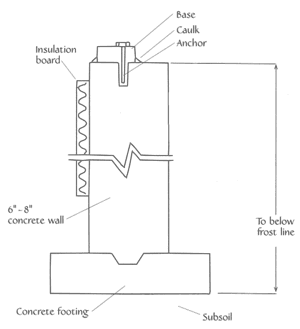There are several different options available when
building a greenhouse foundation (Aspen and Juliana greenhouses even
have a foundation already built for them. Information on them is listed
below the prices for each greenhouse). There are a few things every
foundation should provide:
1. It must be anchored to the ground (Wind gusts can move or turn over a greenhouse because of its low weight to surface area ratio).
2. There must be a way for water to drain out of the greenhouse (If water doesn't drain, it will collect on the floor and become stagnant promoting algae, disease, and insect growth).
3. Measures should be taken to prevent weeds and grass from growing in the greenhouse floor (Greenhouses will provide optimum conditions for weeds to grow along with other the plants you have. Weeds can harbor harmful insects and diseases and should be
kept out of the greenhouse).
4. Foundations for glass covered greenhouses 12' x 16' or larger should have cement footers that extend below the frostline.
Before you start any foundation, you should know the greenhouse's
outside base dimensions: (
Juliana
greenhouse dimensions, Cross Country Greenhouses:
Standard
twinwall dimensions,
Triplewall dimensions,
Lean-to dimensions,
Cape Cod dimensions,
Cottage
dimensions).
Below are three of the most commonly built foundations that provide all
of the features mentioned above, wood,
concrete slab, and concrete wall.
Wood Foundation
Building a foundation out of wood is simple and inexpensive making it an excellent option for most home greenhouses. We recommend using naturally resistant woods, such as cedar, redwood, or cypress. These woods contain substances that inhibit decay. Pressure-treated wood is also available in most areas but contains copper and is corrosive to aluminum. When using pressure-treated wood, a minimum 10 mil thick barrier should be placed between the wood and aluminum frame. Common barrier materials include polyethylene, vinyl, and plastic composite lumber.
The first step to building a greenhouse is constructing a foundation, but before you begin you should have a level site prepared for your greenhouse. We recommend using 4" x 6" (4" x 4" are acceptable for the smaller sizes) timbers for the foundation of an Aspen, Juliana or Cross Country greenhouse. The wood can be cut to size with a standard hand or power saw once it has been purchased.
 Once
you have cut the wood to fit the greenhouse, lay the boards together on
the ground like you are going to set the greenhouse on them (make sure
you remove any rocks, sticks or dirt clogs that keep the board from
laying flush on the ground). Set a level on top of one of the boards
(shown in picture at left). The horizontal bubble should be in-between
the 2 lines marked on the level. This should be done for each board to
ensure that the greenhouse base is level.
Once
you have cut the wood to fit the greenhouse, lay the boards together on
the ground like you are going to set the greenhouse on them (make sure
you remove any rocks, sticks or dirt clogs that keep the board from
laying flush on the ground). Set a level on top of one of the boards
(shown in picture at left). The horizontal bubble should be in-between
the 2 lines marked on the level. This should be done for each board to
ensure that the greenhouse base is level.
 When
the foundation has been leveled, it is time to secure the timbers
together with lag screws (shown in picture to the right). The lag screw
should be three or more inches longer than the first board it is screwed
through to insure a proper hold. Once this has been done for each
corner, we chose to lay our ground cover (shown in the picture below)
under the base and cut any excess fabric around the edges. You can lay
the ground cover after completing the base, but we have found that this
way does a better job of keeping weeds out of the corners of the
greenhouse. Make sure you use a
ground
cover (also called weed barrier) that is made for landscaping and
not black plastic or a tarp. Ground cover will allow water to drain
through the fabric while keeping weeds from growing in your greenhouse.
When
the foundation has been leveled, it is time to secure the timbers
together with lag screws (shown in picture to the right). The lag screw
should be three or more inches longer than the first board it is screwed
through to insure a proper hold. Once this has been done for each
corner, we chose to lay our ground cover (shown in the picture below)
under the base and cut any excess fabric around the edges. You can lay
the ground cover after completing the base, but we have found that this
way does a better job of keeping weeds out of the corners of the
greenhouse. Make sure you use a
ground
cover (also called weed barrier) that is made for landscaping and
not black plastic or a tarp. Ground cover will allow water to drain
through the fabric while keeping weeds from growing in your greenhouse.
 Now that the greenhouse foundation has been built, it is important to
make sure your base is square. To do this, use your tape measure, and
take two diagonal measurements of the base (One from the front left
corner to the back right corner and the other from the front right
corner to the back left corner). The base needs to be adjusted until the
two measurements are the same. You are now ready to anchor your
foundation to the ground (If you are using
earth
anchors
Click Here for directions).
Now that the greenhouse foundation has been built, it is important to
make sure your base is square. To do this, use your tape measure, and
take two diagonal measurements of the base (One from the front left
corner to the back right corner and the other from the front right
corner to the back left corner). The base needs to be adjusted until the
two measurements are the same. You are now ready to anchor your
foundation to the ground (If you are using
earth
anchors
Click Here for directions).
Now that you have finished building a foundation for your new greenhouse, it is time to put in the floor and secure the greenhouse structure to the base.
 We
used gravel to complete our greenhouse floor. There are many options to
choose from for your greenhouse floor, but we recommend sand or small
gravel because they have good drainage. In the picture to the left,
there is about 2 to 3 inches of gravel in the base (you should use
enough to completely cover the ground cover under it).
We
used gravel to complete our greenhouse floor. There are many options to
choose from for your greenhouse floor, but we recommend sand or small
gravel because they have good drainage. In the picture to the left,
there is about 2 to 3 inches of gravel in the base (you should use
enough to completely cover the ground cover under it).
 Now
it is time to secure your greenhouse to the foundation base. We
recommend using 2" galvanized lag screws and washers for this job. Drill
a small hole in the aluminum ridge at the bottom of the greenhouse frame
to start the lag screw in (it is recommended that you insert one screw
for each panel in your greenhouse). After you have drilled all of the
necessary holes, place a washer over each hole and secure the screws
into the greenhouse base as shown in the picture to the right (view is
from outside of greenhouse). For added insulation, you can caulk the
bottom of the aluminum ridge where it meets the the base with sealant.
This will help seal the greenhouse to the base keeping cold air from
entering and warm air from escaping in the winter. That's it! Your
greenhouse is now ready to provide you with many years of enjoyment.
Now
it is time to secure your greenhouse to the foundation base. We
recommend using 2" galvanized lag screws and washers for this job. Drill
a small hole in the aluminum ridge at the bottom of the greenhouse frame
to start the lag screw in (it is recommended that you insert one screw
for each panel in your greenhouse). After you have drilled all of the
necessary holes, place a washer over each hole and secure the screws
into the greenhouse base as shown in the picture to the right (view is
from outside of greenhouse). For added insulation, you can caulk the
bottom of the aluminum ridge where it meets the the base with sealant.
This will help seal the greenhouse to the base keeping cold air from
entering and warm air from escaping in the winter. That's it! Your
greenhouse is now ready to provide you with many years of enjoyment.
Concrete Foundation

- Concrete Slab Foundation -
A concrete slab makes a convenient base for a greenhouse. For an attached structure, the finish floor is generally placed level with or one or two steps below the house floor. For a freestanding greenhouse, the floor should be several inches above the finish outside grade. It is recommended when preparing the concrete foundation that the size be made 1" longer and wider than the greenhouse outside dimensions. A 3 inch thick floor is adequate for home greenhouses. The outside edges should be thicker to give support and resist cracking from frost. A drain should be placed in the center of the greenhouse slab that drains into a gravel pit or into a pipe leading to a drainage area outside the perimeter of the greenhouse. At least 4 inches of compacted gravel or stone should be placed on top of the subsoil to provide drainage. Also, placing a 6 mil polyethylene moisture barrier on top of the gravel or stone will keep the slab dry.
Build a form out of lumber around the perimeter. The top of the form
should be at the finish floor height. Reinforcing wire or fiber should
be added to increase the strength of the slab. Once the concrete has set
(usually about 24 hours), the forms can be removed. Insulation board 1
to 1 1/2 inches thick can be installed vertically around the outside of
the foundation to a depth of 1 to 2 feet. This insulates the floor and
helps keep it warmer in the winter. One recommended option whether you
use a slab or wall is to fasten a 2" x 4" sill on the top of the
foundation. The sill acts as a insulated buffer between the concrete and
the greenhouse frame reducing heat loss. Recommended materials for sills
include naturally resistant woods, such as cedar, redwood, or cypress
and plastic composite lumber. The greenhouse base can be attached using
concrete anchor bolts which are available at most home centers and
hardware stores. Set bolts within 1 ft. of each corner, then
space additional anchor bolts about 4 ft. apart.

- Concrete Wall Foundation -
With this foundation,
the concrete wall is set on a footing below the frost line. This type of
foundation gives good support for heavier structures like greenhouses
glazed with glass. To build the wall, first dig a trench in the soil to
below the frost line and place forms for the footing. Check with the
local building inspector to determine what this depth is and to see if
an inspection is required before the footing is poured. The footing is
usually twice as wide as the wall and equally as thick.
After the footing hardens, place the wall forms on top to pour the
walls. The wall height should be a minimum of 6 inches above grade. At
this point, you should install drains around the perimeter to drain
water away from the site. You can finish the outside wall several ways.
You can leave it plain, paint it, or face it with brick or stone. To
reduce heat loss, attach an inch or two of insulation board to the
inside or outside surface. Now you are ready to backfill soil against
the foundation and grade. One recommended option whether you use a slab
or wall is to fasten a 2" x 4" sill on the top of the foundation. The
sill acts as a insulated buffer between the concrete and the greenhouse
frame reducing heat loss. Recommended materials for sills include
naturally resistant woods, such as cedar, redwood, or cypress and
plastic composite lumber. The greenhouse base can be attached using
concrete anchor bolts which are available at most home centers and
hardware stores. Set bolts within 1 ft. of each corner, then
space additional anchor bolts about 4 ft. apart.